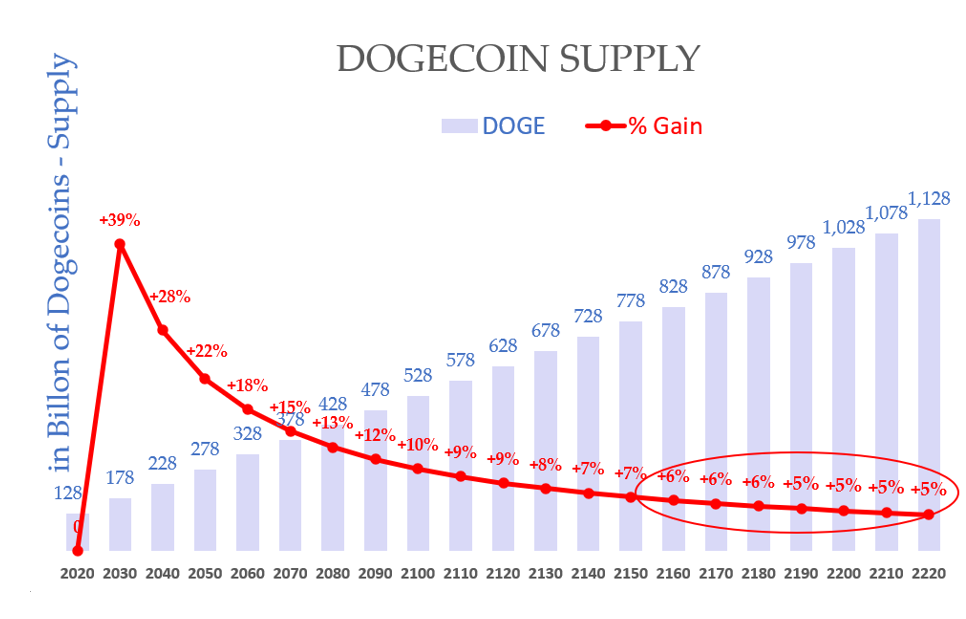This Is How Many Dogecoin Are Left To Mine
Dogecoin theoretically does not have a maximum supply. There are approximately 14.4 million DOGE mined each day with around 140 billion already in circulation.
Key Takeaways:
- As of mid-2023, approximately 140 billion DOGE coins have been mined into circulation.
- Dogecoin does not have a maximum supply, so, there is no limit on the amount of DOGE that can be mined in the future.
- A deflationary mechanism was implemented in 2015, limiting the number of coins that could be minted to 5 billion per year.
TABLE OF CONTENTS
Dogecoin was designed to retain a relatively low value so it could maintain mass appeal among Internet and Web3 users who want to send small amounts of money to one another. At first, Dogecoin was released with a max supply of 100 billion DOGE. Only two years after the coin’s inception, in mid-2015, this amount of Dogecoin was already in circulation. Following this, the cryptocurrency’s developers removed the supply cap meaning that Dogecoin has an unlimited max supply. Therefore, at the time of writing, there is no limit on the amount of DOGE left to be mined.
How Many Dogecoin Have Been Created?
As of mid-2023, approximately 140 billion DOGE have been created and are in circulation. This is by far the greatest number of tokens in circulation of any cryptocurrency in the top 10, sorted by market cap. 100 billion of this 140 billion (over 70%) supply was mined within Dogecoin’s first two years in production.
In response to the high number of daily Dogecoin mined in the first two years, the coin’s developers implemented a new feature to the blockchain’s source code. As of late 2015, only 5 billion DOGE could be minted each year. This was an effort to thwart inflation and ensure the token could maintain a stable value going forward.

The Number of Dogecoins Mined Daily
Dogecoin rewards its miners with each block that is validated, which takes about 60 seconds on average to transfer. Dogecoin’s block reward is 10,000 DOGE, which works out to about 14.4 million DOGE mined each day. When multiplied by 365 days in the year, this figure equates to 5.2 billion DOGE mined every annum, which is barely over the cap imposed by the blockchain’s developers.
Of course, the exact amount of DOGE mined daily can fluctuate wildly depending on network congestion, the number of active miners, and block difficulty. On some days, the average block time may be 70 seconds, while on others, it might be 50.
This Is When The Last Dogecoin Be Mined
Dogecoin does not have a maximum supply, so there is theoretically no particular day when the last DOGE will be mined. However, this is only true as of mid-2023. The Dogecoin developers may implement a limited supply in the future to control inflation or as a response to a community proposal looking to improve the blockchain’s tokenomics. Additionally, there is no guarantee that Dogecoin as we know it will survive indefinitely, with forks, merges, or a total collapse all being potential obstacles.
Dogecoin is ultimately targeting an inflation rate of 5%. With its current annual supply sitting at 5 billion DOGE, this target will only be hit once there are one trillion DOGE in circulation. If all things remain as they are today, this will occur between 2190 and 2200 – so more than a century away.
Dogecoins Have Been Lost For Various Reasons
Data on Dogecoin’s blockchain and wallet addresses containing the token are a little more difficult to analyze due to the network’s extremely high supply. However, there have been several instances where large sums of Dogecoin have been stolen, hacked or simply sitting in inactive accounts for longer than six years.
Dogewallet, a cryptocurrency wallet that is non-custodial in design was targeted by a hack (or alternatively, operated a rug pull scheme) that resulted in the loss of 30 million DOGE – equivalent to around $16,000 USD at the time. The hack occurred on Christmas Day, and a recovery effort known as “SaveDogemas” resulted in enough donations to cover all losses. A report from Business Insider claims that Doge Vault, another Dogecoin wallet, suffered a 2014 hack that resulted in the loss of 111 million DOGE.
Outside of hacks, it is quite likely that many DOGE have been lost due to human error. The coin is designed to appeal to younger investors who are new to the blockchain and may not have taken the required precautions to ensure their assets remain safe. This includes using non-custodial wallets, safely storing seed phrases, and ensuring that all coins are sent on the correct network to the correct wallet address.
Unfortunately, like with most other cryptocurrencies, Dogecoin that is lost, stolen, or stored in an inaccessible wallet cannot be reclaimed. This is why it is extremely important to take several steps to keep crypto tokens secure.




